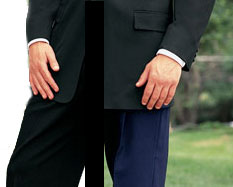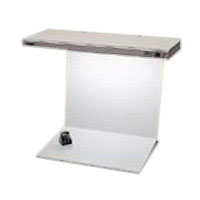Metadata and Mermaids = Metamerism?
 No, sorry. For men, this one's easy to illustrate - have you ever pulled out the black suit, and black pants, checked to make sure they matched outside your closet, and then once you're outdoors, your wife points out that they don't match? For women, it happens with dresses, but somehow, not so often.
No, sorry. For men, this one's easy to illustrate - have you ever pulled out the black suit, and black pants, checked to make sure they matched outside your closet, and then once you're outdoors, your wife points out that they don't match? For women, it happens with dresses, but somehow, not so often.
While this affects you when you're with a client and they are looking at you and worrying that you are color blind, how does this affect you beyond that? Well, it extends to printed output, and specifically, to prints you produce under your own lighting source, and then, upon receipt, the client sees under their light.
While this is a little technical, check out this animation and really study it, to see how, as the color temperature/wavelength of the light changes, the reflected light hue/saturation changes.
Further, Wikipedia has a great explanation of metamerism, and it is among the things that can render a print you are looking at (prior to delivering to a client) good, and then not so good once you've delivered it, because it's looked at under a different light.
The other issue is dry time. When you are producing a final image from a printer, you should wait for the inks to totally dry and confirm that the color is accurate. What you see fresh out of an inkjet printer is not what the final image rendering will look like. While humidity, ink type, paper pourousness type, and others all factor into how long it will take, suffice to say, you need to put from an hour or two, to several hours between printing and final judgement, to ensure proper client satisfaction! One resource is a light hood. The folks over at Luminous Landscape have a great explanation about the benefits of it. It is illumination that is calibrated, by the bulb's life and manufacturers specifications to ensure a known light output. I will, however, say that I do not have one of these, because I don't have an inkjet printer system to speak of, nor do I have plans to put a system like that in place. If I did, however, I would be sure to have one. Further, you should always know - at least as much as possible - what the lightsource where your work is being displayed is like, so you can be sure it will look how you want it to, and the client will too.
One resource is a light hood. The folks over at Luminous Landscape have a great explanation about the benefits of it. It is illumination that is calibrated, by the bulb's life and manufacturers specifications to ensure a known light output. I will, however, say that I do not have one of these, because I don't have an inkjet printer system to speak of, nor do I have plans to put a system like that in place. If I did, however, I would be sure to have one. Further, you should always know - at least as much as possible - what the lightsource where your work is being displayed is like, so you can be sure it will look how you want it to, and the client will too.
When it comes to my suits, it's easiest to just check the brand name to make sure the pants match the jacket, and I then can walk outdoors safe knowing that I don't look the fool.
Please post your comments by clicking the link below. If you've got questions, please pose them in our Photo Business Forum Flickr Group Discussion Threads.

2 comments:
I came to the conclusion last year that I must be slightly colour blind, or at least I'm a poor judge of colour. I've done colour blindness tests and passed but still, when judging colours in prints, I would often not see colour casts until someone pointed them out to me.
My solution was to learn by-the-numbers colour correction in LAB mode. Not only has this allowed me to progress my photographic career, but nowadays I get compliments on the colour in my photos.
Someone who can properly judge colour may make slight adjustments to a picture to correct an overall cast. But because I intricately correct the various casts you get in the highlights, shadows and mid-tones, my pictures are (hopefully) a bit more 'perfect' than those by people who don't use a by-the-numbers approach.
My colour problem has also lead me to make greater use of controllable location lighting. If I can light the picture with known temperatures then I can set the camera's white balance to a specific Kelvin value and then I'll have only a minimum of post-processing to do.
Here's a tutorial I wrote on LAB colour correction:
http://www.meejahor.com/?page_id=91
apple a1079 battery
apple a1045 battery
apple a1078 battery
Post a Comment